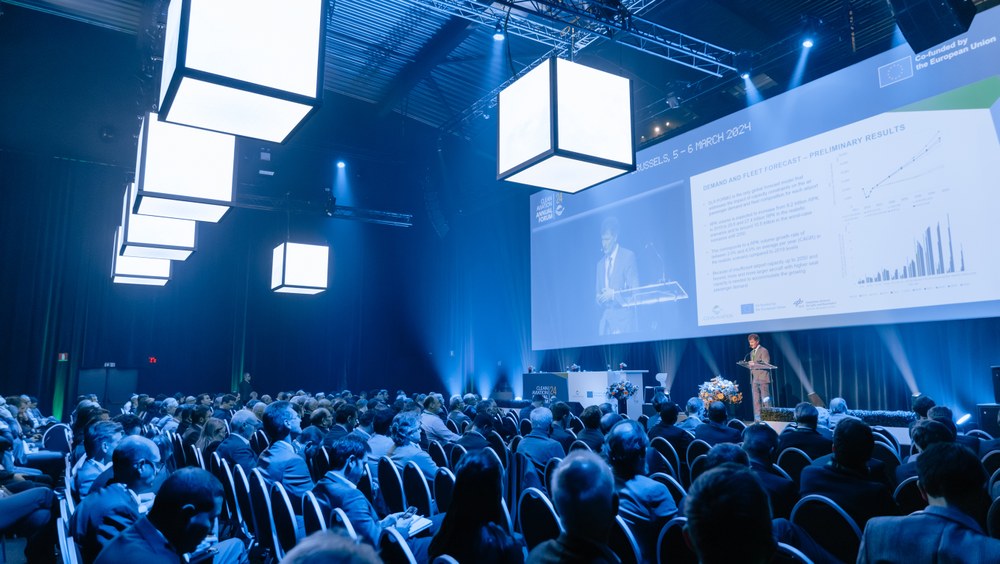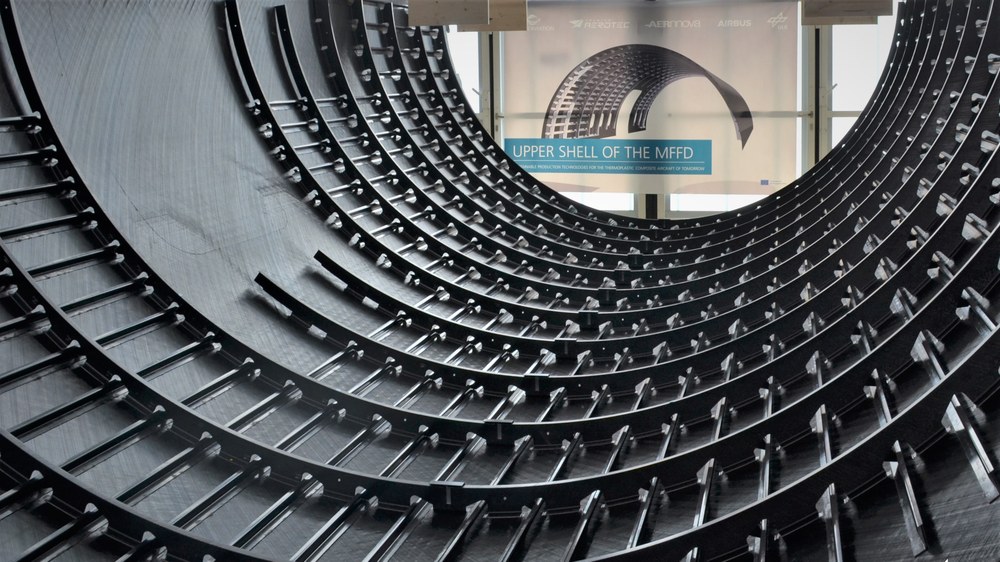European research for climate-friendly aviation

Clean Aviation

Clean Aviation

- European aviation research programme delivers multiple results.
- DLR was involved in a total of 27 projects in Clean Sky 2.
- DLR is a European leader in evaluating and analysing new aviation technologies and their potential.
- Focus: Aeronautics, climate-compatible flight, cooperation
The Clean Aviation Annual Forum in Brussels in March 2024 marked the conclusion of the European aviation research programme Clean Sky 2 (2013-2024) and its continuation under the title Clean Aviation. Over the past ten years, industry and research partners, including the German Aerospace Center (Deutsches Zentrum für Luft- und Raumfahrt; DLR), have conducted intensive research into climate-friendly air transport technologies in a wide range of projects as part of Clean Sky 2. By the end of this year, the programme will have brought together almost 1000 companies from all over Europe in high-tech projects, and delivered more than 100 demonstrators and over 1000 innovative technologies.
"With our contributions to technology and demonstrator platforms in Clean Sky 2 and now in Clean Aviation, we are playing a key role in shaping climate-friendly air transport in Europe," says DLR Divisional Board Member for Aeronautics Markus Fischer. "We are particularly involved in evaluating and analysing new aeronautics technologies and their potential, where DLR is a European leader." As part of the technology evaluation, referred to as the Technology Evaluator for Clean Sky 2, the impact of technological developments in aeronautics on the environment and climate is being comprehensively analysed.
"The overall conditions of the complex research projects in Clean Sky 2 required close coordination with the French aeronautics research organisation ONERA," adds Ulrich Herrmann, the DLR Coordinator for Clean Aviation and Clean Sky 2. "We have achieved a new degree of trust-based cooperation."
DLR has been involved in a total of 27 projects within the context of Clean Sky 2, some of which are worthy of a special mention:
The thermoplastic fuselage of tomorrow
The Multifunctional Fuselage Demonstrator (MFFD) is eight metres long and has a diameter of four metres. This aircraft component is made of thermoplastic CFRP. The prototype was manufactured as part of the Clean Sky 2 programme at DLR in Augsburg in order to test the innovative material and the new technologies for their readiness for use. This unique eight-metre-long fuselage section reduces the weight of the fuselage by approximately one tonne compared to conventional aluminium construction. The reduced weight and higher efficiency of the structure will enable lower energy consumption by future aircraft and therefore lower carbon dioxide emissions.
Next-generation helicopter
It flies faster, further and more efficiently than previous helicopters. It is the Rapid And Cost-Effective Rotorcraft (RACER) demonstrator. Back in 2017, Airbus presented the concept for the new high-speed helicopter with a box-wing design, which could reach speeds of up to 400 kilometres per hour and is intended to offer the best compromise between safety, cost effectiveness and sustainability with a 20 percent reduction in emissions of carbon dioxide, nitrogen oxides and noise. As part of Clean Sky 2, DLR researchers have worked with ONERA to design and evaluate the configurations for the helicopter and have also analysed and demonstrated the acoustic properties of the configuration. The RACER is not only faster, it is also quieter.
From flight test to virtual certification
As part of Clean Sky 2, flight tests were conducted with the DLR Falcon 2000LX ISTAR research aircraft in collaboration with Dassault Aviation. The goal of these flight tests in 2023 was to record, with high precision, the changes in flight behaviour and flow characteristics caused by artificial ice accretion. In the long term, virtual certification will be achieved by proving that changes in the flight behaviour and flow around an aircraft can be predicted numerically. This proof is a prerequisite for airworthiness authorities to be able to accept virtual evidence for certification in the future. The flight campaign successfully generated valuable measurement data, which is now being analysed.

Video: From flight test to virtual certification – Clean Sky 2
Your consent to the storage of data ('cookies') is required for the playback of this video on Youtube.com. You can view and change your current data storage settings at any time under privacy.
New engine technologies
The trend towards ever-larger engines for the various thrust classes requires a broad research approach to the complex gas turbine system, from the fan at the inlet to the complete compressor system, the combustion unit, the turbines and the exhaust. In the Transition project, DLR has developed, adapted, built and operated a realistic turbine test rig as part of Clean Sky 2 together with Rolls-Royce. The improvement of the measurement systems has been developed and their implementation has been pursued. This allows the further industrial application of the test rig to be planned. As part of the 2ShaftCompressor project, DLR worked with MTU Aero Engines in the Clean Sky 2 programme to create and implement an aero-mechanical design for an integrated compressor system consisting of a low-pressure compressor, a short and lightweight transition duct and a high-pressure compressor. The ambitious design targets for reducing fuel consumption will be validated by operating this test stand. These challenging tasks will be continued on a bilateral basis after the completion of the Clean Sky 2 programme
Extraction system can reduce energy consumption and emissions
A key driver for increasing the efficiency of new aircraft is the reduction of drag. The aerodynamic drag on the load-bearing surfaces can be reduced by hybrid laminarisation. Although this has long been known and physically understood, practical implementation in series production has been hindered by the complexity of the systems to date. In the HLFC-WIN project, DLR, together with Airbus and other industrial partners, has designed a fully integrated, production-ready laminarisation system as part of Clean Sky 2. This has been implemented in a ground-based demonstrator. The demonstrator combines the extraction system, the replaceable, variably perforated titanium skin of the wing leading edge, as well as the aircraft's high-lift and de-icing systems. The operation of these systems has been simulated on the ground and even demonstrated in the event of a bird strike. Manufacturing and operating costs have been estimated and operation in a fleet of aircraft has been assessed as economically viable.
Related links
European research for the Green Deal
The European aviation research programmes are based on the 'Fly the Green Deal' vision and the Strategic Research and Innovation Agenda (SRIA), both of which were drawn up as part of the European ACARE (Advisory Council for Aviation Research and Innovation in Europe) technology platform for aviation research.
The Clean Aviation programme, which is now underway and whose first projects began in early 2023, builds on the success of Clean Sky 2 and further develops some of the technologies explored in this earlier programme, taking them to a new level of performance by combining them with new advanced technological concepts.
Europe has set itself the goal of putting more environmentally friendly aircraft into service by 2035 and thus maintaining its global leadership in the air transport industry on the way to climate neutrality in aviation by 2050. The specific goal is to reduce greenhouse gas emissions from new regional and short-haul medium-range aircraft by at least 30 percent by 2035 and to introduce them into commercial flight operations (80 to 100 percent reduction in carbon emissions, including the use of SAF or hydrogen). DLR is working in all areas of aeronautics research to enable the design and realisation of these new aircraft.
